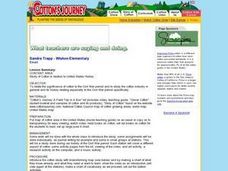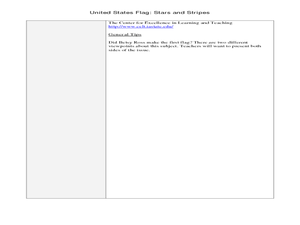Curated OER
Brick by Brick
Students use their previous knowledge of the Pyramid Lake War to help them analyze different primary sources of Fort Churchill. In this source analysis lesson, students work in groups to study 4 different primary sources for Fort...
Curated OER
Dancing in the Desert: The Genie
Fifth graders study nuclear destruction using visual literacy. In this nuclear destruction lesson, 5th graders work in groups to examine a group of pictures that show the destruction of a home by a nuclear blast. They discuss the type of...
Curated OER
The Edge of the Lake
Second graders explore the geography of Nevada. In this map-making instructional activity, 2nd graders use salt dough to create a relief map of Nevada. Students label the landforms and bodies of water that are studied and specified in...
Curated OER
Pioneer Scramble
Learners explore the concept of Manifest Destiny. In this Westward Movement lesson, students study why Americans emigrated west in the 1840s and 1850s. Learners create interactive timelines, write exploration reports, and complete an art...
Curated OER
Research North Carolina Symbols for a North Carolina Symbols Scrapbook
Fourth graders research North Carolina Symbols in a social studies textbook. They choose one to research in the computer lab for a scrapbook.
Curated OER
Michaelangelo Game
Students play the game, "Reading a Painting" to review social studies facts. They read a painting of a particular time period trying to determine clues to remember facts. They work in teams to identify the time, place, and important...
Curated OER
Friendship
Students investigate the concept of friendship as part of a four lessons unit which integrates literature with language arts, family life, social studies, or religious studies. Peace, cooperation, social justice, and multicultural...
Curated OER
From Claws to Jaws: Atlantic Regions of the United States
Students explore New England, Mid-Atlantic, and southeastern regions of the United States. In this social studies thematic unit, students research a state and make a regional quilt. Students wrte a book report and read two novels...
Curated OER
Political Cartoons
Students analyze and interpret political cartoons, then use this knowledge to create their own.
Curated OER
What is a Democracy?
Students identify what makes a country democratic and compare United States and Indian political party symbols. They create their own political party and party symbol. They create a campaign speech, participate in the voting process...
Curated OER
Combating Corrosion
Study corrosion on bronze statues with a hands-on activity. As pupils place a penny in water with salt, they observe the changes in the penny throughout a period of a week. They then analyze the pre-conservation and the...
Curated OER
Contributions of Ancient Egypt and China
Second graders study the contributions of Ancient Egypt and China, which have had an impact on world history, with emphasis on written language, laws, calendars, and architectural monuments such as the Pyramids and the Great Wall of China.
Curated OER
Flawed Democracies
Ninth graders examine the struggle for equal opportunity. In this American Government lesson, 9th graders create a timeline outlining various groups' struggles for equal opportunity. Students research and construct a timeline to...
Curated OER
Baseball Cards
Learners read a short story on baseball cards and reflect on Honus Wagner's decision to withdraw his card. In this baseball cards lesson plan, students study how children used cards in the 1930's and express their understanding of Honus...
Curated OER
all About the States
Students conduct Internet research about the states and use educational software to graphically organize the facts they have studied. As a class, students create posters and bulletin boards of the 50 states.
Curated OER
Cotton Journey
Students use "Cotton Journey-A Field Trip In A Box" kit to relate the significance of cotton to the Civil War period and to study the cotton industry in general.
Curated OER
Our Compromise, Our Constitution
Sixth graders explore, analyze and study our constitutional government and become aware of the purpose of our government. They assess the basic rights that are protected by the United States Constitution through graphic organizers and...
National First Ladies' Library
Will the Real Pocahontas Please Stand Up?
Learners explore the life of Pocahontas and Powhatan Indians. After studying information on a given website, students compare and contrast what they read about Pocahontas and what they previously thought of her. They explore life in a...
Curated OER
Causes of School Violence
Students examine school violence. In this school violence lesson, students listen to a teacher-led lecture regarding statistics and studies about school violence. Students discuss bullying and school violence.
Curated OER
Why Are Celebrations Important?
Pupils complete a variety of activities in their study of Chinese culture. They explore the Chinese New Year, zodiac, calligraphy, dragon kites, lanterns, games, and songs among others.
Curated OER
Modern Art Styles of Matisse
Students study the history of Matisse as an artist and focus upon his influences upon the style of art that he was famous for. The learners perform research about the life and works. Then they create a work of art that is similar to the...
Curated OER
United States Flag: Stars and Stripes
Students study the symbols and history of the United States flag. In this United States flag lesson, students complete a KWL about the U.S. flag. Students then visit a website to learn about the American flag and discuss the topic....
Curated OER
Critical Reading, Imaginative Writing and the Montage
Students discuss the difference between primary and secondary sources and consider how an exhibit is researched. They design and create a montage that reflects themselves in a social and historical context.
Curated OER
Native American Gender Roles in Maryland
Students compare conditions of women in America and other lands (including colonists), and discover that women's status in their community was directly related to social hierarchy, religious culture, and natural environment in which they...























